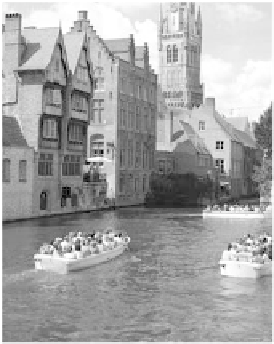Travel Reference
In-Depth Information
orIEntatIon
With Renoir canals, pointy gilded architecture, vivid time-tunnel
art, and stay-a-while cafés, Bruges is a heavyweight sightseeing
destination, as well as a joy. Where else can you ride a bike along a
canal, munch mussels and wash them down with the world's best
beer, savor heavenly chocolate, and see Flemish Primitives and
a Michelangelo, all within 300 yards of a bell tower that jingles
every 15 minutes? And do it all without worrying about a language
barrier?
The town is Brugge (BROO-ghah) in Flemish, and Bruges
(broozh) in French and English. Its name comes from the Viking
word for wharf. Right from the start, Bruges was a trading center.
In the 11th century, the city grew wealthy on the cloth trade.
By the 14th century, Bruges' population was 35,000, as large
as London's. As the middleman in the sea trade between northern
and southern Europe, it was one of the biggest cities in the world
and an economic powerhouse. In addition, Bruges had become the
most important cloth market in northern Europe.
In the 15th century, while England and France were slugging
it out in the Hundred Years' War, Bruges was the favored residence
of the powerful Dukes of Burgundy—and at peace. Commerce
and the arts boomed. The artists Jan van Eyck and Hans Memling
had studios here.
But by the 16th century, the harbor had silted up and the
economy had collapsed. The Burgundian court left, Belgium
became a minor Habsburg possession, and Bruges' Golden Age
abruptly ended. For generations, Bruges was known as a mysteri-
ous and dead city. In the 19th century, a new port, Zeebrugge,
brought renewed vitality to the area. And in the 20th century,
tourists discovered the town.
Today, Bruges prospers because of tourism: It's a uniquely



















